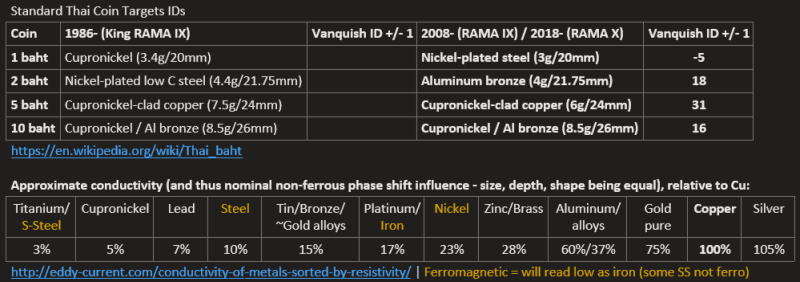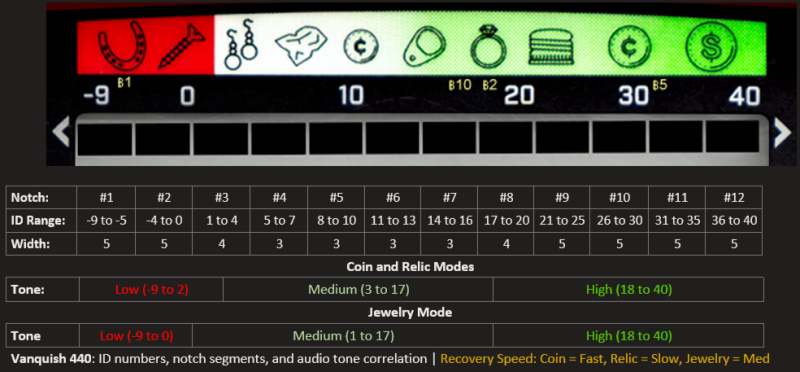-
Posts
177 -
Joined
-
Last visited
Content Type
Forums
Detector Prospector Home
Detector Database
Downloads
Posts posted by mcjtom
-
-
Is there some basic summary of sound interpretation (Minelab flutty tones processing perhaps) that could help me learn how to interpret what I'm hearing? For instance, hearing iron burp at the edge of the coil for b-caps, or 'round' vs. not so round sound etc.?
-
With Deism vanquishing the airwaves, in other news: https://detecthistory.com/news/broken-vanquish-metal-detectors-what-vanquish-owners-should-consider/
-
Is that a legit story and if so, did anyone figure out where the finds ware coming from?
https://nypost.com/2020/12/12/mysterious-gold-jewelry-washes-up-on-venezuelan-beach/
-
In gold prospecting, lead ‘trash’ he’s been mentioned. Where does the lead come from - naturally formed or things like bullets and shot?
-
On 12/8/2021 at 1:26 AM, phrunt said:
You'll never get to understand how it works, just follow the theory of higher gain gives more chance of tuning out EMI as it is affected by more EMI and you should be fine, it's what that article alludes to also.
I've been doing highest sensitivity noise cancel on my VLF's and I think it does a good job.
Looks like the ‘Pascal’s wager’ is the best course of action…
-
That sounds like an idea - maybe it internally increases the sensitivity when noise cancelling already?
Would EMI noise cancel be also related to the recovery speed (I guess the return signal sampling rate)? In other words, since the modes on Vanquish differ in recovery speed, would noise cancel procedure choose different quiet set of channels depending on the Mode, or perhaps it doesn't matter, but one of the modes (Coins, with the shortest recovery speed?) be the one that would amplify the EMI the most and therefore help to detect and reduce it?
I tried to find some posts related to this at Tom Dankowski's board, but I'm still not quite sure...
-
But the article does say that the principle should apply to VLF detectors as well? Do you think that Minelab VLFs do Noise Cancel differently?
-
Thanks! But, now I'm properly confused by this article:
I'm not sure how to read it, but it seems to suggest that both the sensitivity and the signal sampling resolution affect Auto Noise Cancel (so the signal may not be that raw)... The advise is to enhance the noise (I would think higher Sensitivity and faster Recovery Speed on VLF) before running the Auto Noise and than go back to proper settings - at least that’s what I understood.
p.s. Lots of Thai coins, artifacts, and gold, as soon as I figure out how to turn it on... Promise! 🙂
Is there a way to field test it somehow - does the Auto Noise use ‘raw’ signal or the one modified by some user’s settings? I can’t hear much difference, but that doesn’t mean there is none…
-
Also, would the different Vanquish ‘modes’ require different Automatic Noise Cancel calibrations? My understanding is that they differ in recovery times, not channel weighing like in the Equinox.
-
Everybody else has probably have seen it, but even though they poke fun at Garret, it feels friendly…
-
On startup, the detector performs ‘Automatic Noise Cancel’, which I imagine shifts the frequencies mixture in order to try to minimize some types of EMI noise. Does it matter what the Sensitivity is set to when this procedure is invoked? e.g. if Sensitivity is low enough for the detector not to see the EMI in some channels, would the Automatic Noise Cancel also not see noise in those channels and potentially choose them as being OK, or would the procedure ignore the Sensitivity setting altogether?
-
On 12/1/2021 at 12:52 AM, PimentoUK said:
"Segments and tones just lump the ID ranges together? "
Broadly speaking, yes, that's what happens.
However .... the audio and the visual ID's do not HAVE to correlate. Audio performance needs to be fairly 'immediate' , whereas a visual identifier can be slower. Advantage can be taken of this difference to produce visual data that is more 'averaged', to produce more repeatable/consistent/less jumpy information.
I've no idea what ML do on their Eqx/Vanquish models, but as an example from First Texas Products:
The Teknetics T2 machine used exactly the same processing for audio ID and visual ID. It's design was later developed into the improved 'park-hunting variant', the Fisher F75. This used different processing for the two outputs, and their publicity material drew attention to this improved target ID ability. As a user of the F75, I have seen the odd 'discrepancy' that this produces. We have a lot of coke ( part-burnt coal ) in our UK farmland, and it often reads in the very-low non-ferrous range, but can be in the 'large iron' zone, or up as high as some coins. Sometimes a lump will consistently give 'Iron' audio, but low non-ferrous ID's on the screen.“Sometimes a lump will consistently give 'Iron' audio, but low non-ferrous ID's on the screen.“
Just curious how notching on F75 would work in this situation: e.g. if you notched out the low non-ferrous IDs would that block the iron audio that those lumps produced even though the ferrous ID range corresponding to this audio was not notched out?
-
I understand that the Nokta Pulse Dive uses pulse induction. I imagine that precludes discrimination? Also, there are 2 coils for it: 14 and 20 cm. Do the coil size on PI detectors have similar meaning as in VLF ones? Could anyone briefly comment on how this detector behaves in reality? Cheers.
-
Would anyone know what material the detector’s shaft is made of?
-
-
I looked at my old photos from Laos and there is one with a metal detector in it - a UXO team clearing a village. Would anybody know what detector they have used?

-
Would I be correct to think that a digital detector, no matter what the internal processing, produce, first, some target ID number, which is later binned with other numbers to produce an appropriate notch flashing and sound tone?
i.e. if a detector, like Vanquish 440, has 12 discrimination segments, but a range of 50 IDs, is it still reporting the target IDs at the resolution of 1/50 of the full ID scale? Segments and tones just lump the ID ranges together?
-
Quote
The dredging itself is harmless, just putting muddy water in a muddy river.
I'm not sure if it's that simple.
-
-
Cheers for that! I've updated the conductivity table above a little - it's all approximate, but there is a trend.
-
I tried to figure it out on my own, but I can't: if a ground balance setting (either manual, or automatic, or tracking) influences the filtering of the low spacial-change ground signals based on their phase shift/type (ferrous for magnetite, conductive for salty wet beach, or something in between or both), and not the amount of mineralisation, why an 'unbalanced' detector would beep differently (i.e. on coil pumping up vs. down) depending on in which direction it is unbalanced?
-
-
After a brief encounter with a Mental Detector, I came to my senses and got Vanquish 440. Trying to learn what it does, I think I figured out what the actual correlation between the target ID values, notch segments display, and the audio tones is. Perhaps it could be useful to others:
The target ID scale on this detector is non-linear, with the middle range between 0 and 20 stretched and both ends compressed.
The break points between tones, except for one case of Low-Med in Jewelry Mode, do not correspond to break-points between notch segments.
The yellow values, below the target identification guide graphics, represent the standard response (+/-1) for modern (Rama IX/X, 2008+) Thai Baht coins, when the target signal is strong.
-
Hello,
I’m not sure where to post it: would anybody know a good documentary on metal detecting/treasure hunting (technology, applications, history) of interest to upper high school students?
Cheers!





Sound Tutorial
in Metal Detector Advice & Comparisons
Posted
Many thanks for this. I found this primer on the topic, which reads reasonably: https://nwdetectors.com/blogs/news/how-to-avoid-digging-iron-trash-with-the-minelab-equinox-800
A question(s) on Minelab tones (Vanquish 440 of course, but it's probably not that different in Equinox in limited tones modes).
What does the loudness of the sound when sweeping the coil indicate? I'm not even sure anymore if there is a loudness involved or it's just on and off square sound amplitude...
What is the logic behind setting the mid/high tones breakpoint at ID 17/18?